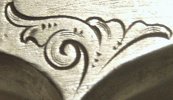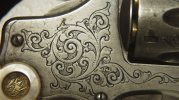Well worn, used to be blue, combined w/some previous owner apparently using the heavy hand of sandpaper as a cleaner. Knowing very little I ask if any might be familiar w/this style of engraving.
On the Trade Mark pic at 4:30 there's a collar that appears as a dinner napkin ring on the floral vine. I tend to lean towards that move being continued on other pieces.
Over on the right the side plate engraving extends under the cylinder where many have left this area blank.
The scroll & floral somewhat different though in the same vein. Perhaps a clean palette unburdened by a S&W Trade Mark allowed for a bit of a different take.
On the hump, w/o appearing to read too much into the work, the first partial scroll looks a lot as the letter 'G' as compared to the more complete scroll opposite/beside. Perhaps it is merely from the canvas including the 90* hump w/limited space. If you follow the scroll from the inside they both move CW. Maybe that induces the 'G' in me.
I stacked three macro lens and included a bit of optical zoom to frame the pics. Then I cropped them.
Increasing the magnification showed me an inconsistency. The little round balls huddled together providing contrast/background are fairly consistent. [I call it grapeshot because as a rule they are seemingly stacked together.] Except around the Trade Mark. I see three single strikes, six in a single file, three forming a triangle among others. Not so much as an afterthought it would seem the work stopped there w/o being finished.
Any help in identifying the style would be appreciated. If nothing else enjoy the large pics of what is left from the ravages of time, owners and neglect coupled w/abuse.
On the Trade Mark pic at 4:30 there's a collar that appears as a dinner napkin ring on the floral vine. I tend to lean towards that move being continued on other pieces.
Over on the right the side plate engraving extends under the cylinder where many have left this area blank.
The scroll & floral somewhat different though in the same vein. Perhaps a clean palette unburdened by a S&W Trade Mark allowed for a bit of a different take.
On the hump, w/o appearing to read too much into the work, the first partial scroll looks a lot as the letter 'G' as compared to the more complete scroll opposite/beside. Perhaps it is merely from the canvas including the 90* hump w/limited space. If you follow the scroll from the inside they both move CW. Maybe that induces the 'G' in me.
I stacked three macro lens and included a bit of optical zoom to frame the pics. Then I cropped them.
Increasing the magnification showed me an inconsistency. The little round balls huddled together providing contrast/background are fairly consistent. [I call it grapeshot because as a rule they are seemingly stacked together.] Except around the Trade Mark. I see three single strikes, six in a single file, three forming a triangle among others. Not so much as an afterthought it would seem the work stopped there w/o being finished.
Any help in identifying the style would be appreciated. If nothing else enjoy the large pics of what is left from the ravages of time, owners and neglect coupled w/abuse.












